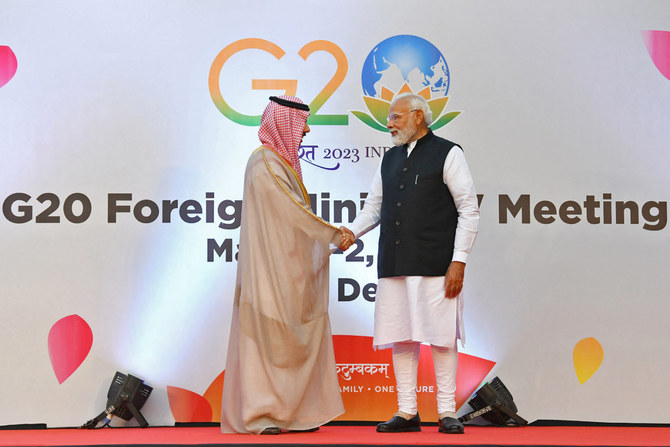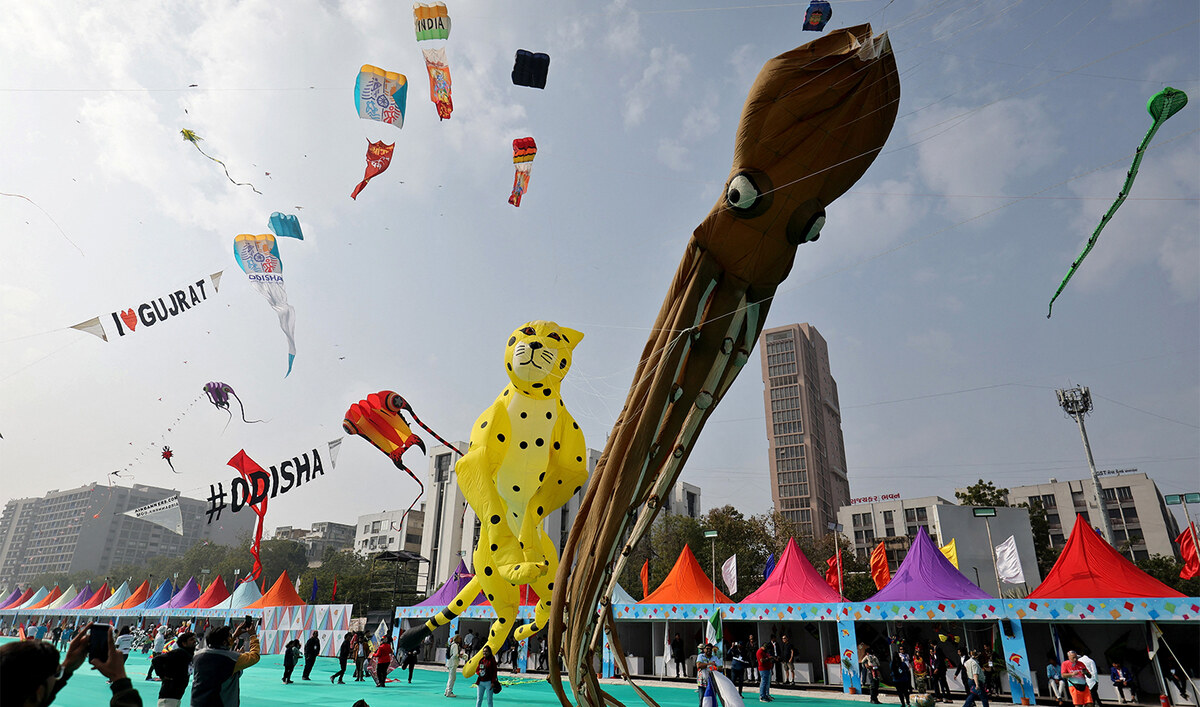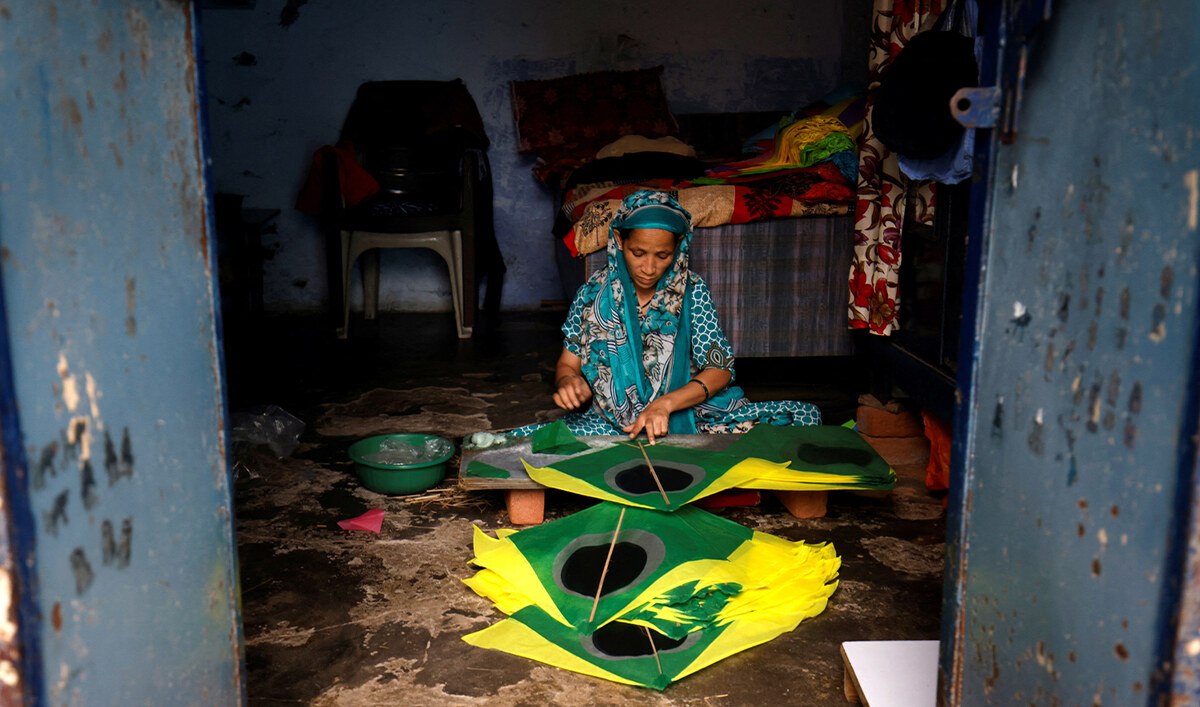RIYADH/NEW DELHI: Relations with Saudi Arabia have been steadily gaining prominence on India’s foreign policy agenda over the past three decades. But their full potential has only lately been realized thanks to cooperation around the G20 platform.
Saudi-Indian ties began to see a new level of engagement in 2019 following Crown Prince Mohammed bin Salman’s visit to New Delhi and the establishment of a strategic cooperation council.
During Saudi Arabia’s presidency of the Group of 20 leading rich and developing nations in 2020, the two countries started to forge new partnerships and programs and these developed further when India took over the presidency this year.

Ashwini Vaishnaw and Abdullah Al-Swaha sign an agreement on digitization and electronic manufacturing in Bengaluru, India, on Aug. 18, 2023. (SPA)
“Relations between the two nations were already growing and G20 has provided them another platform where new possibilities emerge for engagement on a range of issues,” Dr. Harsh V. Pant, vice president for studies and foreign policy at the Observer Research Foundation in Delhi, told Arab News.
“The relations have gained momentum. I think the relations have acquired greater depth with the G20 process.”
When the working group meetings began in January, Saudi Arabia was engaged from the beginning, sending multiple high-level delegations, and also serving as patron and co-organizer of some key meetings — especially those contributing to policy related to sustainable development, food security, health, entrepreneurship, startups and technology.

Dr. Maymouna Al-Khalil, secretary general of the Saudi Family Affairs Council, speaks at the Ministerial Conference on Women’s Empowerment. (Supplied)
All of these sectors are central to both Saudi Arabia’s Vision 2030 diversification and transformation plan and India’s development strategy, making further cooperation not only promising but possibly also long term.
“While one can look at energy, trade, defense relationship and security relationship, where the two sides have been cooperating, given the commonality of challenges … the G20 platform expands the area of operation for India and Saudi Arabia and allows new possibilities to emerge,” Pant said.
“This lays the foundation for a much more productive and broad-based engagement beyond the G20 … perhaps you will see a lot of activity on the range of fronts, because certainly groundwork has been laid.”
FASTFACTS
India holds the presidency of this year’s Group of 20 advanced economies, previously held by Saudi Arabia in 2020.
Saudi delegations have been in India attending summits on finance, health, youth and other fields of cooperation.
Saudi Crown Prince Mohammed bin Salman and Indian Prime Minister Narendra Modi made reciprocal official visits in 2019.
1.88 million people of Indian origin live and work in Saudi Arabia.
Saudi Health Minister Fahad bin Abdurrahman Al-Jalajel told Arab News he was expecting new developments in the health sector.
“This year’s health ministers’ meeting and the joint finance meeting, which were held on Aug. 18 and 19, reaffirmed previous health initiatives that were announced during the Saudi G20 presidency,” he said.
“The launching of the Global Initiative on Digital Health in cooperation with the World Health Organization on Aug. 19 was a highlight.”

Fahd Al-Rasheed, adviser to the Saudi Council of Ministers, speaks at the G20’s Urban 20 Mayoral Summit in Ahmedabad, India, on July 7, 2023. (AN photo)
The Kingdom’s experience in digital health solutions garnered particular interest.
“During the meetings, I met with several ministers including the Indian minister of health. Investment in Saudi public health is a much sought-after topic,” Al-Jalajel said.
“I deeply appreciated the invitation by the Indian presidency to speak at the launching ceremony about our experience in digital health transformation and the implementation of cutting-edge technologies such as the Seha Virtual Hospital.”

Saudi Arabia’s assistant culture minister Rakan bin Ibrahim Al-Tawq represented the Kingdom at the G20 Culture Ministers' Meeting in Varanasi, India, on Saturday. (SPA)
Launched in February 2022, this is the world’s largest virtual hospital and one of the priority initiatives of Saudi Arabia’s health sector transformation program.
The G20 platform has also provided room for Indian tech entrepreneurs to contribute to these initiatives and for the exchange of knowledge and experience between the two countries.

Saudi Arabia’s minister of commerce Majid bin Abdullah Al-Qasabi held 12 meetings with ministers and officials of the G20 countries in India earlier this week. (Twitter/@malkassabi)
Dr. Huda Alfardus, CEO of Riyadh-based HealthGena and a member of several Saudi delegations to G20 meetings, told Arab News there was “a positive momentum” in relations and cooperation in the field of investment and technology transfer.
“HeathGena is actively working with the Indian Embassy in Riyadh to create cross-country economic opportunities,” she said.
“Now we are running a joint program to take 15 Saudi startups to India and bring a delegation of companies from India next week to Riyadh to help them localize in Saudi Arabia.”
Meetings throughout the year have resulted not only in tangible economic results but also included initiatives to bring the two nations closer together. Some of the Saudi delegates, who like Alfardus took part in the G20 Young Entrepreneurs Alliance Summit, have already signed agreements with Indian educational institutions.

Dr. Huda Alfardus, CEO of HealthGena, speaks to Arab News at the G20 Young Entrepreneurs Alliance Summit in New Delhi, India, on July 15, 2023. (AN Photo)
“Promoting people-to-people connections through cultural and educational exchanges can foster mutual understanding and friendship,” she said.
“Encouraging student exchanges, cultural events, and collaborations between universities can contribute to long-term relationship building.”
At the YEA summit, which was held in Delhi in July, Prince Fahad bin Mansour, the chair of the board of directors of Entrepreneurship Vision and president of the Saudi G20 Young Entrepreneurs Alliance, told Arab News that new joint projects were expected soon.
“We have some entities from the private sector as investors that are looking for opportunities over here and we found a lot of investors from India that are planning to invest in Saudi,” he said.
“I think what we have is a huge opportunity and we’re going to capitalize on that as we move forward."

Saudi delegation head Prince Fahad bin Mansour, center, surrounded by international delegates to the G20 Young Entrepreneurs Alliance Summit in New Delhi on July 15, 2023. (AN photo)
The two countries are already capitalizing on what they have achieved, as they had come to the “forefront of steps toward sustainable development, inclusive growth and energy transition,” Muddassir Quamar, associate professor at the Center for West Asian Studies at Jawaharlal Nehru University in Delhi, told Arab News.
“The enthusiastic Saudi participation in G20 meetings in India underlines the confidence the two countries have in each other’s leadership and G20 agenda. India, too, had taken a proactive approach in participating in G20 events under the Saudi presidency in 2020,” he said.
“India’s G20 presidency focus includes sustainable development goals, inclusive growth, digital public goods, just energy transition, health, education and employment, as well as international peace and harmony. This fits well within the priorities of Saudi Arabia’s developmental agenda and the Vision 2030 program as well as within the scope of Indo-Saudi ties.”

Abdulrahman bin Saleh Al-Fageeh, CEO of petrochemicals group Saudi Basic Industries Corporation and chief of the Saudi delegation, serve as a panelist at a plenary session of the B20 Summit in New Delhi, India, on Aug. 27, 2023. (AN Photo)
For Quamar, the fact that relations had gained momentum was reflected in how “vibrant” they had become and with a “significant strategic component encompassing political, economic, cultural and security ties.”
He expects a further boost will come from the G20 leaders’ summit on Saturday and Sunday.
“G20 can become a platform for greater Indo-Saudi cooperation at multilateral forums and through multilateral organizations,” he said.
“Saudi Arabia and India can further strengthen their cooperation and partnership in areas such as sustainable development and inclusive growth with sensitivity to environmental and climate change concerns.
“The theme of India’s G20 presidency is ‘One Family, One Earth, One Future,’ and this gives a universal message for humanity to work together toward a sustainable and harmonious future for the world, and this can prove to be the new glue in strengthening Saudi-India ties.”

Saudi India Venture Studio CEO Mansour Al-Sanooni, left, signs an agreement with Pravaig Dynamics CEO Siddhartha Bagri in the presence of Prince Fahad bin Mansour, at the G20 Young Entrepreneurs Alliance Summit in New Delhi, on July 16, 2023. (Pravaig Dynamics photo)
Mohammed Soliman, strategic technologies director at the Middle East Institute in Washington, agreed that Saudi-Indian engagement had gained more global significance and attention in recent months.
Saudi Arabia and India knew well how to use the G20 platform to their international advantage, he told Arab News.
“Both nations perceive opportunities in the emerging multipolar world and view the G20 as an effective platform for addressing global challenges and showcasing their economic and political influence.
“The most significant development or change in Saudi-Indian ties, attributable to the G20, is the elevation of their engagement on the global stage.”






























